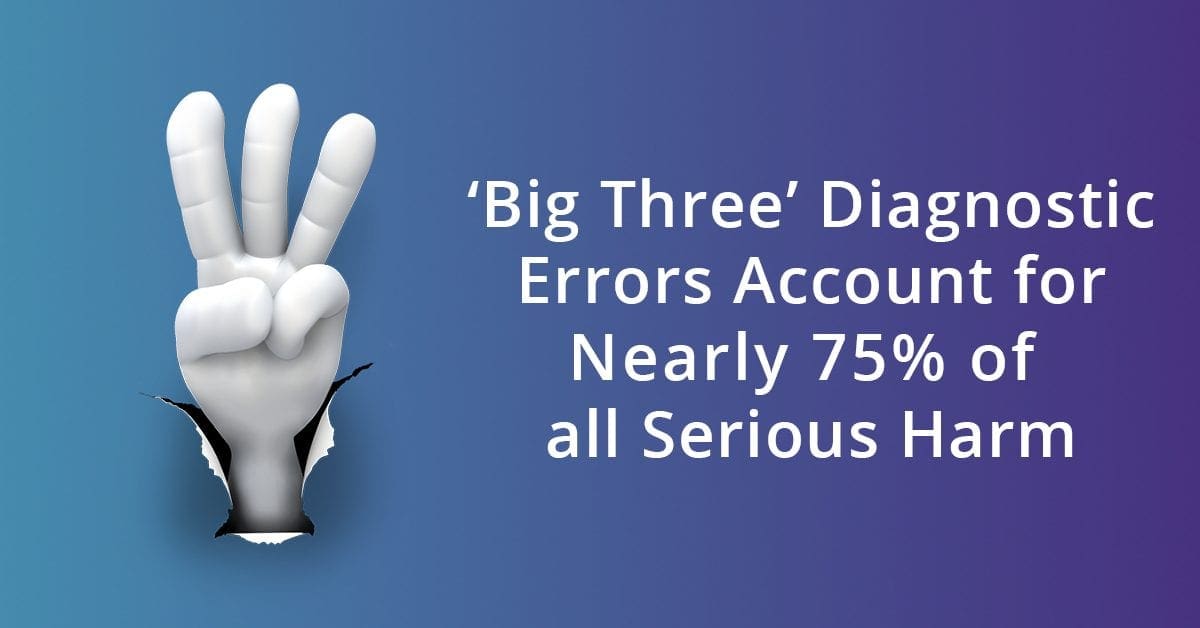Call us toll-free: 800-878-7828 — Monday - Friday — 8AM - 5PM EST

By John Commins for Health Leaders
KEY TAKEAWAYS
- Diagnostic errors that led to death or permanent disability were linked with misdiagnosed cancers (37.8%), vascular events (22.8%) and infections (13.5%) — which led the researchers to refer to them as the ‘big three.’
- Half of the most-severe harm cases ended in patient death and the other half resulted in permanent disability.
- Failures of clinical judgment caused more than 85% of the misdiagnosed cases.
Misdiagnoses in treatments for “big three” conditions – cardiovascular events, cancers and infections – comprise 74% of all serious harms from diagnostic errors, according to a new study published Thursday in Diagnosis.
The study also found that 34% of malpractice cases for death or permanent disability began with an errant or delayed diagnosis, making it the biggest cause of serious harms among medical errors.
“We know that diagnostic errors happen across all areas of medicine. There are over 10 thousand diseases, each of which can manifest with a variety of symptoms, so it can be daunting to think about how to even begin tackling diagnostic problems,” said study lead author David Newman-Toker, MD, director of the Johns Hopkins Armstrong Institute Center for Diagnostic Excellence, in remarks accompanying the report.
“Our findings suggest that the most serious harms can be attributed to a surprisingly small number of conditions. It still won’t be an easy or quick fix, but that gives us both a place to start and real hope that the problem is fixable,” he said.
Sifting through reams of malpractice insurance claims in the national Comparative Benchmarking System database, the researchers analyzed all 11,592 diagnostic error cases between 2006 and 2015 that resulted in $1.8 billion in malpractice payouts over the decade.
“We use malpractice claims to track this issue because there aren’t many measures for diagnostic error. It’s not so much that they are prone to litigation- it is that they often result in significant harm and that can lead to litigation,” Newman-Toker said.
They found that misdiagnoses were the most common, catastrophic and costly medical mistakes. Specifically, diagnostic errors that led to death or permanent disability were linked with misdiagnosed cancers (37.8%), vascular events (22.8%) and infections (13.5%) — which led the researchers to refer to them as the “big three.”
Within those “big three” areas, the researchers identified 15 specific conditions that combined account for nearly half of all the serious, misdiagnosis-related harms.
The top conditions in each category are stroke, sepsis and lung cancer, respectively. Other most-commonly misdiagnosed conditions include heart attack, venous thromboembolism, aortic aneurysm and dissection, arterial thromboembolism, meningitis and encephalitis, spinal infection, pneumonia, endocarditis, and breast, colorectal, prostate and skin cancers.
The median age of the patients with errant diagnoses was 49, and more than half were female.
For children and young adults under age 20, harms most often were from missed infections (27.6%) rather than vascular events (7.1%) or cancers (9.1%). The reverse was true for middle-aged and older adults.
Half of the most-severe harm cases ended in patient death and the other half resulted in permanent disability, the researchers report.
The claims data show that failures of clinical judgment caused more than 85% of the misdiagnosed cases. The researchers said those findings demonstrate that health systems must do more to support clinicians’ bedside diagnoses, improve access to specialists, nurture clinician teamwork, and encourage patient engagement in the diagnoses.
The Hopkins researchers also found that 71% of the diagnostic errors took place in either in outpatient clinics, where misdiagnoses were often cancer-related, or emergency departments, for missed infections and vascular events.
Newman-Toker acknowledged a “built-in bias” in the malpractice cases because malpractice attorneys target cases, such as cancer, “since there’s usually more of a paper trail.”
To account for the bias, the researchers looked at earlier studies that used nonclaims data that still found that roughly three-quarters of diagnostic error cases were associated with the big three disease categories.
